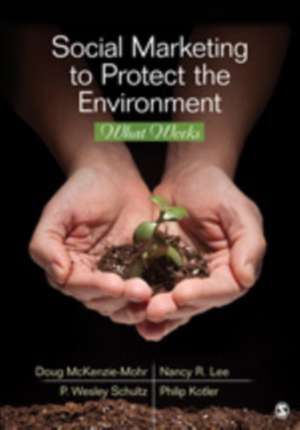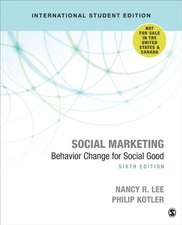Social Marketing to Protect the Environment: What Works
Autor Doug McKenzie-Mohr, Nancy R. Lee, P. Wesley Schultz, Philip Kotleren Limba Engleză Paperback – 5 iul 2011
- Describe a variety of environmental issues
- Give examples of the numerous changes in behaviours and/or practices that would contribute to reducing the problem
- Provide mini-cases that illustrate the successful use of social marketing principles along with tools to influence this behaviour in similar situations
- Review what worked and what could have been improved.
A final section provides future directions and recommendations.
Preț: 557.08 lei
Preț vechi: 655.39 lei
-15% Nou
Puncte Express: 836
Preț estimativ în valută:
106.61€ • 110.89$ • 88.01£
106.61€ • 110.89$ • 88.01£
Carte tipărită la comandă
Livrare economică 14-28 aprilie
Preluare comenzi: 021 569.72.76
Specificații
ISBN-13: 9781412991292
ISBN-10: 1412991293
Pagini: 256
Ilustrații: Illustrations
Dimensiuni: 178 x 254 x 14 mm
Greutate: 0.45 kg
Ediția:1
Editura: SAGE Publications
Colecția Sage Publications, Inc
Locul publicării:Thousand Oaks, United States
ISBN-10: 1412991293
Pagini: 256
Ilustrații: Illustrations
Dimensiuni: 178 x 254 x 14 mm
Greutate: 0.45 kg
Ediția:1
Editura: SAGE Publications
Colecția Sage Publications, Inc
Locul publicării:Thousand Oaks, United States
Recenzii
Behaviour change is central to the pursuit of sustainability. The book details how to use community-based social marketing to motivate environmental protection behaviours as diverse as water and energy efficiency, alternative transportation and watershed protection. With case studies of innovative programmes from around the world, including the USA, Canada, Australia, Spain, and Jordan, the authors present a clear process for motivating social change for both residential and commercial audiences. The case studies illustrate conservation applications for both work and home and show how community-based social marketing can be harnessed to foster more sustainable communities.
Cuprins
Foreword
Preface
Section I: Introduction
Chapter 1: Introduction: Fostering Sustainable Behavior
Section II: Influencing Behaviors in the Residential Sector
Chapter 2: Reducing Waste
The Problem
Potential Behavior Solutions
Case: No Junk Mail (Bayside, Australia)
Case: Decreasing Use of Plastic Bags and Increasing Use of Reusable Ones (Ireland)
Case: Increasing Curbside Recycling of Organics (Halifax, Nova Scotia)
Other Notable Programs
Summary
Questions for Discussion
References
Chapter 3: Protecting Water Quality
The Problem
Potential Behavior Solutions
Case: Influencing Natural Yard Care (King County, Washington)
Case: Scooping the Poop (Austin, Texas)
Other Notable Programs
Summary
Questions for Discussion
References
Chapter 4: Reducing Emissions
The Problem
Potential Behavior Solutions
Case: Anti-Idling: Turn it Off (Toronto, Canada)
Case: TravelSmart (Adelaide, South Australia)
Other Notable Programs
Questions for Discussion
Summary
References
Chapter 5: Reducing Water Use
The Problem
Potential Behavior Solutions
Case: Reducing Water Use (Durham Region, Canada)
Case: Ecoteams (United States, Netherlands, United Kingdom)
Other Notable Programs
Summary
Questions for Discussion
References
Chapter 6: Reducing Energy Use
The Problem
Potential Behavior Solutions
Case: The One Tonne Challenge to Reduce Greenhouse Gas Emissions (Canada)
Case: ecoENERGY to Promote Home Energy Efficiency (Canada)
Other Notable Programs
Summary
Questions for Discussion
References
Chapter 7: Protecting Fish and Wildlife Habitats
The Problem
Potential Behavior Solutions
Case: Reducing Deliberate Grass Fires (Wales, United Kingdom)
Case: Planting Eastern Shore Natives (Virginia)
Case: Seafood Watch: Influencing Sustainable Seafood Choices (United States)
Other Notable Programs
Summary
Questions for Discussion
References
Section III: Influencing Behaviors in the Commerical Sector
Chapter 8: Reducing Waste
The Problem
Potential Behavior Solutions
Case: Green Dot, Europe's Packaging Waste Reduction
Case: Fork It Over: Reusing Leftover Food (Portland, Oregon)
Case: Anheuser-Busch: An EPA WasteWise Hall of Fame Member
Other Notable Programs
Summary
Questions for Discussion
References
Chapter 9: Protecting Water Quality
The Problem
Potential Behavior Solutions
Case: Chuyen Que Minh, Reducing Insecticide Use Among Rice Farmers (Vietnam)
Case: Dirty Dairying (New Zealand)
Other Notable Programs
Summary
Questions for Discussion
References
Chapter 10: Reducing Emissions
The Problem
Potential Behavior Solutions
Case: Bike Sharing Programs
Case: ATT's & Nortel's Telework Programs (United States, Canada)
Other Notable Programs
Summary
Questions for Discussion
References
Chapter 11: Reducing Water Use
The Problem
Potential Behavior Solutions
Case: Conserving Water in Hotels (Seattle, Washington)
Case: Fighting the Water Shortage Problem in Jordan
Other Notable Programs
Summary
Questions for Discussion
References
Chapter 12: Reducing Energy Use
The Problem
Potential Behavior Solutions
Case: Using Prompts to Turn Off Lights (Madrid, Spain)
Case: Norms-based Messaging to Promote Hotel Towel Reuse (California)
Other Notable Programs
Summary
Questions for Discussion
References
Chapter 13: Concluding Thoughts and Recommendations
Preface
Section I: Introduction
Chapter 1: Introduction: Fostering Sustainable Behavior
Section II: Influencing Behaviors in the Residential Sector
Chapter 2: Reducing Waste
The Problem
Potential Behavior Solutions
Case: No Junk Mail (Bayside, Australia)
Case: Decreasing Use of Plastic Bags and Increasing Use of Reusable Ones (Ireland)
Case: Increasing Curbside Recycling of Organics (Halifax, Nova Scotia)
Other Notable Programs
Summary
Questions for Discussion
References
Chapter 3: Protecting Water Quality
The Problem
Potential Behavior Solutions
Case: Influencing Natural Yard Care (King County, Washington)
Case: Scooping the Poop (Austin, Texas)
Other Notable Programs
Summary
Questions for Discussion
References
Chapter 4: Reducing Emissions
The Problem
Potential Behavior Solutions
Case: Anti-Idling: Turn it Off (Toronto, Canada)
Case: TravelSmart (Adelaide, South Australia)
Other Notable Programs
Questions for Discussion
Summary
References
Chapter 5: Reducing Water Use
The Problem
Potential Behavior Solutions
Case: Reducing Water Use (Durham Region, Canada)
Case: Ecoteams (United States, Netherlands, United Kingdom)
Other Notable Programs
Summary
Questions for Discussion
References
Chapter 6: Reducing Energy Use
The Problem
Potential Behavior Solutions
Case: The One Tonne Challenge to Reduce Greenhouse Gas Emissions (Canada)
Case: ecoENERGY to Promote Home Energy Efficiency (Canada)
Other Notable Programs
Summary
Questions for Discussion
References
Chapter 7: Protecting Fish and Wildlife Habitats
The Problem
Potential Behavior Solutions
Case: Reducing Deliberate Grass Fires (Wales, United Kingdom)
Case: Planting Eastern Shore Natives (Virginia)
Case: Seafood Watch: Influencing Sustainable Seafood Choices (United States)
Other Notable Programs
Summary
Questions for Discussion
References
Section III: Influencing Behaviors in the Commerical Sector
Chapter 8: Reducing Waste
The Problem
Potential Behavior Solutions
Case: Green Dot, Europe's Packaging Waste Reduction
Case: Fork It Over: Reusing Leftover Food (Portland, Oregon)
Case: Anheuser-Busch: An EPA WasteWise Hall of Fame Member
Other Notable Programs
Summary
Questions for Discussion
References
Chapter 9: Protecting Water Quality
The Problem
Potential Behavior Solutions
Case: Chuyen Que Minh, Reducing Insecticide Use Among Rice Farmers (Vietnam)
Case: Dirty Dairying (New Zealand)
Other Notable Programs
Summary
Questions for Discussion
References
Chapter 10: Reducing Emissions
The Problem
Potential Behavior Solutions
Case: Bike Sharing Programs
Case: ATT's & Nortel's Telework Programs (United States, Canada)
Other Notable Programs
Summary
Questions for Discussion
References
Chapter 11: Reducing Water Use
The Problem
Potential Behavior Solutions
Case: Conserving Water in Hotels (Seattle, Washington)
Case: Fighting the Water Shortage Problem in Jordan
Other Notable Programs
Summary
Questions for Discussion
References
Chapter 12: Reducing Energy Use
The Problem
Potential Behavior Solutions
Case: Using Prompts to Turn Off Lights (Madrid, Spain)
Case: Norms-based Messaging to Promote Hotel Towel Reuse (California)
Other Notable Programs
Summary
Questions for Discussion
References
Chapter 13: Concluding Thoughts and Recommendations
Descriere
Shows how social marketing can be successfully used to change environmental behaviour














